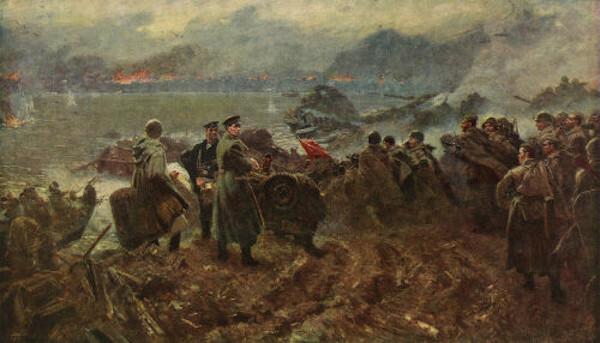What was the Battle of Stalingrad?
One of the most important battles fought during the SecondWarWorldtook place in the Russian city of Stalingrad (today, Volgograd), then belonging to Unitysoviet. THE Battle of Stalingrad it took place from July 17, 1942 to February 2, 1943 and was a milestone in the direct confrontation between the Germans and the Soviets in the front Eastern European. But why is this battle considered so important? And what was the final result arising from it? That's what we'll see next.
Break between Germans and Soviets
To understand what gave rise to the Battle of Stalingrad, we need to remember that the Soviet Union and Nazi Germany signed the famous CovenantGerman-soviet of non-aggression, on August 23, 1939, a few days before the start of World War II. This pact assured the Germans the invasion of Poland and the incursion of troops into other countries, without the USSR becoming involved in the conflict.
However, this agreement would sooner or later be broken, and the break occurred in 1941 with the
OperationBarbarossa – a coordinated attack by the German Armed Forces against the USSR. The attacks of Operation Barbarossa were intended to completely dominate Soviet territory, just as there were occurred with Poland, but Hitler and his officers failed to complete their strategic encirclement and the operation was halves.Then, for the next two years, 1942 and 1943, the battles waged in Eastern Europe between the Germans and the Soviets were offshoots of the Nazis' initial attempt at dominance. The Battle of Stalingrad was the most emblematic of them.
battle development
The city of Stalingrad was located in the Caucasus region, on the banks of the Volga River, being strategically important, as it was at the center of the river and rail routes for oil and iron ore raw materials Caucasians. Dominating Stalingrad meant for the Nazis to control a significant part of the basic industry of the USSR, in addition to strangling the country, leaving Moscow isolated. Thus, a large part of the German force was directed to Stalingrad. The attack was in charge of the General Paulus, commander of the German VI Army.

The maneuvers began on July 17, 1942, but the massive attacks took effect from August 21, when the infantry and the tank division managed to cross the Don River and head towards the Volga and Stalingrad, as historian Antony recounts Beevor:
At dawn on 21 August, infantry from the 51st Corps crossed the Don in assault boats. A bridgehead was conquered, floating bridges were built across the river, and the following afternoon Lieutenant Colonel Hans Hube's 16th Panzer Division began advancing. Just before the first lights of August 23, Hube's panzer vanguard battalion, commanded by Colonel Hyazinth Graf Strachwitz, advanced towards the rising sun and Stalingrad, situated just 65 kilometers away. East. The Don steppe, an expanse of charred grass, was hard as stone. [1]
When the platoons reached Stalingrad, the commanders still had the air support of 1,200 planes. The August 23 attack was one of the heaviest of World War II, certainly the most concentrated of the front Eastern. A thousand tons of incendiary bombs were dropped on Stalingrad. 40,000 civilians died in just the first two days of the attack, civilians who were unaware of the invasion plan, as Beevor highlights:
The townspeople would never forget that Sunday, August 23, 1942. Oblivious to the approach of German forces, civilians were convexting in the sun in the center of a city that stretched more than 30 kilometers along the curve of the west bank of the Volga. In the streets, loudspeakers broadcast warnings of air strikes, but it wasn't until the anti-aircraft batteries started firing that people ran for cover. [2]
Resistance to the German attack was initially under the command of the generalChuikov, commander of the 62nd Soviet Army. Preventing the fall of Stalingrad was one of the top priorities of Joseph Stalin, and its defense should be uncompromising, even with starving and unequipped combatants. One of Stalin's most cruel measures towards the Red Army occurred in this context. it was the Order No. 227, which authorized the summary shooting of any combatant who “showed fear or hesitation”.
soviet victory
The clashes dragged on over the next three months, with successive German onslaughts, but the course changed from November onwards with the arrival of winter. In the final two months of 1942, German troops no longer had the same firepower and tenacity as in August. Furthermore, the winter of the East had already put the onslaught of Operation Barbarossa in the past year to the fore. The solution was to redefine strategy and retreat, but Hitler forced General Paulus and his men to remain at their posts.
At the same time, the troops of Chuikov began to receive reinforcements from the generalZukov, which had under its control the armies of Vatuin, Rokossovsky and Yeremenko. Between November 19 and 23, the Soviet counteroffensive began, which, with the “help” of winter, put an end to the German attack. The battle officially ended on February 2 of the following year.
GRADES
[1] BEEVOR, Antony. The Second World War. Trans. Cristina Cavalcanti. Record Publisher: Rio de Janeiro, 2015. P. 381.
[2] Ibid. P. 382.
By Cláudio Fernandes
History teacher
